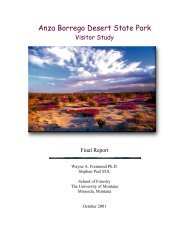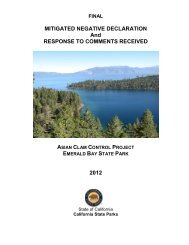- Page 1 and 2:
3. Planning Influences 3 Planning I
- Page 3 and 4:
3. Planning Influences − Californ
- Page 5 and 6:
3. Planning Influences The Statewid
- Page 7 and 8:
3. Planning Influences Valley Initi
- Page 9 and 10: 3. Planning Influences 3.2.5 Cal Fi
- Page 11 and 12: 3. Planning Influences 3.3.1.3 Open
- Page 13 and 14: 3. Planning Influences Community Pl
- Page 15 and 16: 3. Planning Influences needs and de
- Page 17 and 18: 3. Planning Influences measures wou
- Page 19 and 20: 3. Planning Influences Southern Cal
- Page 21 and 22: 3. Planning Influences Use Area. Re
- Page 23 and 24: 3. Planning Influences available da
- Page 25 and 26: 3. Planning Influences 3.4.1.5 Scen
- Page 27 and 28: 3. Planning Influences • A marina
- Page 29 and 30: 3. Planning Influences increased mi
- Page 31 and 32: 3. Planning Influences Constraints
- Page 33 and 34: 3. Planning Influences Constraints
- Page 35 and 36: 4. Plan Overview 4 Plan Overview Th
- Page 37 and 38: 4. Plan Overview continuing to enco
- Page 39 and 40: 4. Plan Overview 4.2.1.1 Scenic/Aes
- Page 41 and 42: 4. Plan Overview • Provide for st
- Page 43 and 44: 4. Plan Overview Guidelines • Emp
- Page 45 and 46: 4. Plan Overview Goal RES-V6 • Id
- Page 47 and 48: 4. Plan Overview offering activitie
- Page 49 and 50: 4. Plan Overview Goal VIS-T1 • Pr
- Page 51 and 52: 4. Plan Overview Guidelines • Con
- Page 53 and 54: 4. Plan Overview • Secondary Inte
- Page 55 and 56: 4. Plan Overview coordinate plannin
- Page 57 and 58: 4. Plan Overview Goal OPS-A2 • Pr
- Page 59: 4. Plan Overview Guidelines • Dev
- Page 63 and 64: S4 CSP S
- Page 65 and 66: 4. Plan Overview U S RD RN SP P Urb
- Page 67 and 68: 4. Plan Overview • Existing Featu
- Page 69 and 70: 4. Plan Overview up to fish or be n
- Page 71 and 72: 4. Plan Overview motorized boating
- Page 73 and 74: 4. Plan Overview The FC Zones were
- Page 75 and 76: 4. Plan Overview South of O’Neill
- Page 77 and 78: 4. Plan Overview All three action a
- Page 79 and 80: 4. Plan Overview Table 4-1 Proposed
- Page 81 and 82: 4. Plan Overview Table 4-1 Proposed
- Page 83 and 84: 4. Plan Overview Table 4-1 Proposed
- Page 85 and 86: 4. Plan Overview after 2014, a wate
- Page 87 and 88: S4 CSP S
- Page 89 and 90: 4. Plan Overview that are indigenou
- Page 91 and 92: 4. Plan Overview remain accessible
- Page 93 and 94: Work with DFG to reduce conflicts w
- Page 95 and 96: 4. Plan Overview additions would be
- Page 97 and 98: 4. Plan Overview relatively small a
- Page 99 and 100: Work with DFG to reduce conflicts w
- Page 101 and 102: 4. Plan Overview Alternative 4 woul
- Page 103 and 104: 4. Plan Overview Use Area, consiste
- Page 105 and 106: 4. Plan Overview Table 4-2 Visitor
- Page 107 and 108: 4. Plan Overview in the Plan Area (
- Page 109 and 110: 4. Plan Overview Table 4-4 Plan Are
- Page 111 and 112:
5 Environmental Analysis 5.1 Introd
- Page 113 and 114:
5. Environmental Analysis or Ms. El
- Page 115 and 116:
5. Environmental Analysis 5.2.3 Ass
- Page 117 and 118:
5. Environmental Analysis 5.2.4.2 G
- Page 119 and 120:
5. Environmental Analysis Populatio
- Page 121 and 122:
5. Environmental Analysis − Creat
- Page 123 and 124:
5. Environmental Analysis Trail and
- Page 125 and 126:
5. Environmental Analysis have a on
- Page 127 and 128:
5. Environmental Analysis • Incor
- Page 129 and 130:
5. Environmental Analysis Table 5-1
- Page 131 and 132:
5. Environmental Analysis density i
- Page 133 and 134:
5. Environmental Analysis to wildla
- Page 135 and 136:
5. Environmental Analysis 5.4.2.4 M
- Page 137 and 138:
5. Environmental Analysis discussed
- Page 139 and 140:
5. Environmental Analysis • Alter
- Page 141 and 142:
5. Environmental Analysis greater t
- Page 143 and 144:
5. Environmental Analysis O’Neill
- Page 145 and 146:
5. Environmental Analysis • Distu
- Page 147 and 148:
5. Environmental Analysis could dis
- Page 149 and 150:
5. Environmental Analysis occur at
- Page 151 and 152:
5. Environmental Analysis • Groun
- Page 153 and 154:
5. Environmental Analysis Alternati
- Page 155 and 156:
5. Environmental Analysis Goal RES-
- Page 157 and 158:
5. Environmental Analysis 5.4.5.3 E
- Page 159 and 160:
5. Environmental Analysis specific
- Page 161 and 162:
5. Environmental Analysis recreatio
- Page 163 and 164:
5. Environmental Analysis visitor d
- Page 165 and 166:
5. Environmental Analysis reduce re
- Page 167 and 168:
5. Environmental Analysis When spec
- Page 169 and 170:
5. Environmental Analysis major; ho
- Page 171 and 172:
5. Environmental Analysis signage t
- Page 173 and 174:
5. Environmental Analysis reduce cr
- Page 175 and 176:
5. Environmental Analysis plan, in
- Page 177 and 178:
5. Environmental Analysis Impact Lo
- Page 179 and 180:
5. Environmental Analysis Impact Ta
- Page 181 and 182:
5. Environmental Analysis 5.5 NEPA/
- Page 183 and 184:
5. Environmental Analysis sensitivi
- Page 185 and 186:
5. Environmental Analysis environme
- Page 187 and 188:
5. Environmental Analysis Full impl
- Page 189 and 190:
5. Environmental Analysis Quinto So
- Page 191 and 192:
5. Environmental Analysis Developme
- Page 193 and 194:
6 Consultation, Coordination, and D
- Page 195 and 196:
6. Consultation, Coordination, and
- Page 197 and 198:
6. Consultation, Coordination, and
- Page 199 and 200:
6. Consultation, Coordination, and
- Page 201 and 202:
6. Consultation, Coordination, and
- Page 203 and 204:
6. Consultation, Coordination, and
- Page 205 and 206:
7 References ABAG (Association of B
- Page 207 and 208:
7. References Borba, P. 2003.Water
- Page 209 and 210:
7. References ———. 2010. iADA
- Page 211 and 212:
7. References CSP, Architectural Co
- Page 213 and 214:
7. References Archaeological Report
- Page 215 and 216:
7. References Kyle, D.E. 2002. Hist
- Page 217 and 218:
7. References MWH and Jones & Stoke
- Page 219 and 220:
7. References ———. 2011d. San
- Page 221 and 222:
7. References ———. 2007. 2007
- Page 223 and 224:
7. References ———. 2000. Enda
- Page 225 and 226:
8 Glossary of Terms Aesthetics: The
- Page 227 and 228:
8. Glossary of Terms Fish and Wildl
- Page 229 and 230:
8. Glossary of Terms Runoff: That p
- Page 231 and 232:
9 Report Contributors 9.1 Bureau of
- Page 233 and 234:
9. Report Contributors 9.5 Consulta
- Page 235:
Appendix A Reclamation List of Agre
- Page 238 and 239:
Appendix A. Reclamation List of Agr
- Page 240 and 241:
Appendix A. Reclamation List of Agr
- Page 242 and 243:
Appendix A. Reclamation List of Agr
- Page 244 and 245:
Appendix A. Reclamation List of Agr
- Page 246 and 247:
Appendix A. Reclamation List of Agr
- Page 248 and 249:
Appendix A. Reclamation List of Agr
- Page 250 and 251:
Appendix A. Reclamation List of Agr
- Page 252 and 253:
Appendix A. Reclamation List of Agr
- Page 254 and 255:
Appendix A. Reclamation List of Agr
- Page 256 and 257:
This page intentionally left blank
- Page 259 and 260:
Appendix B. Biological Survey Forms
- Page 261 and 262:
Appendix B. Biological Survey Forms
- Page 263 and 264:
Appendix B. Biological Survey Forms
- Page 265 and 266:
Appendix B. Biological Survey Forms
- Page 267:
Appendix C Public Involvement Progr
- Page 270 and 271:
Appendix C. Public Involvement Prog
- Page 272 and 273:
Appendix C. Public Involvement Prog
- Page 274 and 275:
Appendix C. Public Involvement Prog
- Page 276 and 277:
Appendix C. Public Involvement Prog
- Page 278 and 279:
Appendix C. Public Involvement Prog
- Page 280 and 281:
Appendix C. Public Involvement Prog
- Page 282 and 283:
Appendix C. Public Involvement Prog
- Page 284 and 285:
Appendix C. Public Involvement Prog
- Page 286 and 287:
Appendix C. Public Involvement Prog
- Page 288 and 289:
Appendix C. Public Involvement Prog
- Page 290 and 291:
Appendix C. Public Involvement Prog
- Page 292 and 293:
Appendix C. Public Involvement Prog
- Page 294 and 295:
Appendix C. Public Involvement Prog
- Page 296 and 297:
Appendix C. Public Involvement Prog
- Page 298 and 299:
Appendix C. Public Involvement Prog
- Page 300 and 301:
Appendix C. Public Involvement Prog
- Page 302 and 303:
Appendix C. Public Involvement Prog
- Page 304 and 305:
Appendix C. Public Involvement Prog
- Page 306 and 307:
Appendix C. Public Involvement Prog
- Page 308:
This page intentionally left blank
















